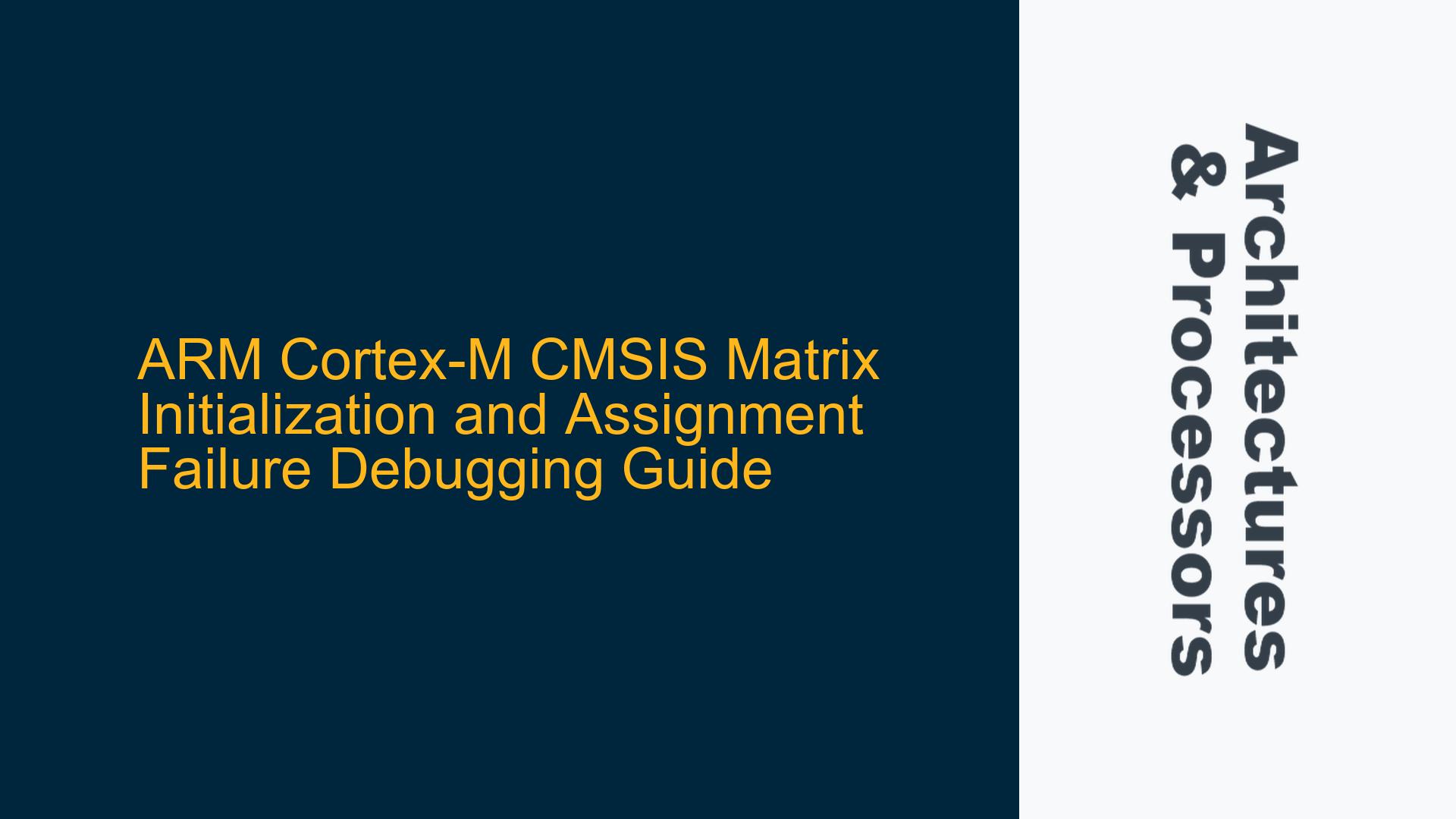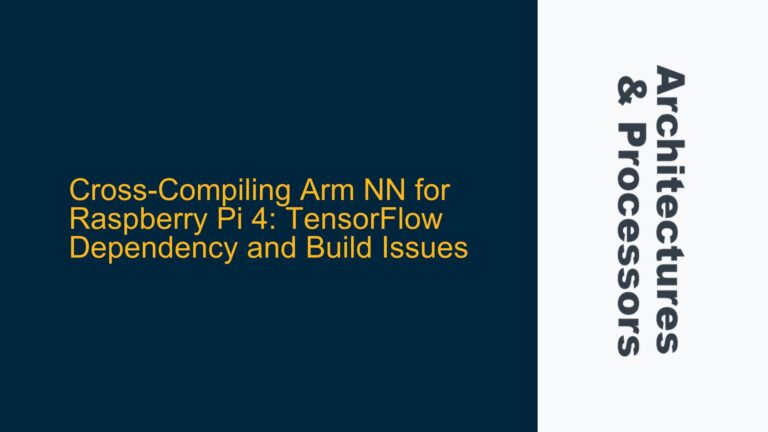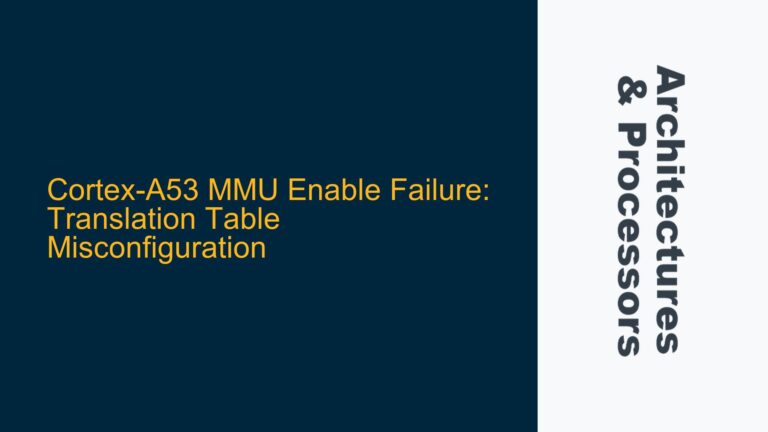ARM Cortex-M Matrix Initialization and Data Assignment Failure
The issue at hand involves the failure of matrix data assignment after initializing an arm_matrix_instance_f32 structure using the CMSIS DSP library on an ARM Cortex-M processor. Specifically, the matrix structure Hm is initialized with a static array H, but subsequent assignments to Hm.pData do not persist, and the values remain zero. This behavior suggests a potential issue with the initialization process, memory alignment, or compiler optimizations interfering with the expected behavior.
The arm_matrix_instance_f32 structure is part of the CMSIS DSP library, which provides optimized functions for digital signal processing on ARM Cortex-M processors. The structure is defined as follows:
typedef struct {
uint16_t numRows; // Number of rows in the matrix
uint16_t numCols; // Number of columns in the matrix
float32_t *pData; // Pointer to the data array
} arm_matrix_instance_f32;
The initialization function arm_mat_init_f32 is used to set up the matrix structure:
void arm_mat_init_f32(
arm_matrix_instance_f32 *S,
uint16_t nRows,
uint16_t nCols,
float32_t *pData
);
In the provided code snippet, the matrix Hm is initialized with a 1×3 matrix using the static array H. However, after assigning values to Hm.pData, the values in H remain zero. This indicates that the matrix initialization or data assignment process is not functioning as expected.
Memory Alignment, Compiler Optimizations, and Initialization Errors
The failure of matrix data assignment can be attributed to several potential causes, including memory alignment issues, compiler optimizations, and errors in the initialization process.
Memory Alignment Issues
ARM Cortex-M processors require proper alignment of data in memory to ensure correct access and manipulation. Misaligned data can lead to unexpected behavior, especially when dealing with floating-point operations. The static array H used to initialize the matrix must be properly aligned to the required boundary for floating-point data. If the array is not aligned correctly, the matrix operations may fail silently, resulting in the observed behavior.
Compiler Optimizations
Compiler optimizations can sometimes interfere with the expected behavior of code, especially in trivial examples where the compiler may optimize away assignments or operations that it deems unnecessary. In this case, the compiler might optimize away the assignments to Hm.pData if it determines that the values are not used elsewhere in the code. This can lead to the values remaining zero even after the assignments.
Initialization Errors
Errors in the initialization process can also cause the matrix data assignment to fail. If the arm_mat_init_f32 function is not called correctly, or if the parameters passed to it are invalid, the matrix structure may not be properly initialized. This can result in the pData pointer not being set correctly, leading to the observed behavior where the values in H remain zero.
Debugging and Resolving Matrix Initialization and Assignment Issues
To debug and resolve the matrix initialization and assignment issues, follow these steps:
Verify Memory Alignment
Ensure that the static array H used to initialize the matrix is properly aligned to the required boundary for floating-point data. The alignment requirement for float32_t data on ARM Cortex-M processors is typically 4 bytes. Use the __attribute__((aligned(4))) attribute to enforce proper alignment:
static float H[3] __attribute__((aligned(4))) = {0};
This ensures that the array H is aligned to a 4-byte boundary, which is necessary for correct floating-point operations.
Disable Compiler Optimizations
To rule out the possibility of compiler optimizations interfering with the code, disable optimizations temporarily and check if the issue persists. In GCC, this can be done using the -O0 flag:
gcc -O0 -o my_program my_program.c
If the issue is resolved with optimizations disabled, it indicates that the compiler optimizations were interfering with the code. In this case, review the code to ensure that the assignments to Hm.pData are not optimized away. You can also use the volatile keyword to prevent the compiler from optimizing away the assignments:
volatile float32_t *pData = Hm.pData;
pData[0] = 0.971422f;
pData[1] = -0.900052f;
pData[2] = -0.327298f;
Check Initialization Parameters
Verify that the parameters passed to the arm_mat_init_f32 function are correct. Ensure that the number of rows and columns specified match the dimensions of the static array H. Additionally, ensure that the pData pointer is correctly set to the address of the array H:
arm_mat_init_f32(&Hm, 1, 3, (float32_t *)H);
If the parameters are incorrect, the matrix structure may not be properly initialized, leading to the observed behavior.
Debugging with Breakpoints and Memory Inspection
Use a debugger to set breakpoints and inspect the memory contents of the array H and the matrix structure Hm. Set a breakpoint after the assignments to Hm.pData and inspect the values in H to verify if the assignments are being made correctly. If the values in H are still zero, it indicates that the assignments are not being made as expected.
Use CMSIS DSP Library Debugging Functions
The CMSIS DSP library provides debugging functions that can be used to verify the correctness of matrix operations. Use the arm_mat_scale_f32 function to scale the matrix and verify if the values in H are updated correctly:
float32_t scale = 2.0f;
arm_mat_scale_f32(&Hm, scale, &Hm);
If the values in H are updated correctly after scaling, it indicates that the matrix initialization and data assignment are functioning correctly. If not, it suggests that there is an issue with the initialization or data assignment process.
Review CMSIS DSP Library Documentation
Review the CMSIS DSP library documentation to ensure that the matrix initialization and data assignment functions are being used correctly. The documentation provides detailed information on the usage of the arm_mat_init_f32 function and the arm_matrix_instance_f32 structure. Ensure that the parameters passed to the function are correct and that the matrix structure is properly initialized.
Example Code with Debugging Steps
The following example code demonstrates the debugging steps outlined above:
#include "arm_math.h"
#include <stdio.h>
int main() {
// Ensure proper alignment of the static array
static float H[3] __attribute__((aligned(4))) = {0};
// Initialize the matrix structure
arm_matrix_instance_f32 Hm;
arm_mat_init_f32(&Hm, 1, 3, (float32_t *)H);
// Assign values to the matrix data
Hm.pData[0] = 0.971422f;
Hm.pData[1] = -0.900052f;
Hm.pData[2] = -0.327298f;
// Verify the values in the static array
printf("H[0] = %f\n", H[0]);
printf("H[1] = %f\n", H[1]);
printf("H[2] = %f\n", H[2]);
// Use CMSIS DSP library debugging functions
float32_t scale = 2.0f;
arm_mat_scale_f32(&Hm, scale, &Hm);
// Verify the scaled values in the static array
printf("Scaled H[0] = %f\n", H[0]);
printf("Scaled H[1] = %f\n", H[1]);
printf("Scaled H[2] = %f\n", H[2]);
return 0;
}
This code initializes the matrix structure Hm with the static array H, assigns values to the matrix data, and verifies the values in the array. It also uses the arm_mat_scale_f32 function to scale the matrix and verify the scaled values in the array. If the values in H are updated correctly, it indicates that the matrix initialization and data assignment are functioning correctly. If not, it suggests that there is an issue with the initialization or data assignment process.
Conclusion
The failure of matrix data assignment after initializing an arm_matrix_instance_f32 structure using the CMSIS DSP library on an ARM Cortex-M processor can be attributed to memory alignment issues, compiler optimizations, or errors in the initialization process. By verifying memory alignment, disabling compiler optimizations, checking initialization parameters, using debugging tools, and reviewing the CMSIS DSP library documentation, you can identify and resolve the issue. The example code provided demonstrates the debugging steps and can be used as a reference to ensure that the matrix initialization and data assignment are functioning correctly.






